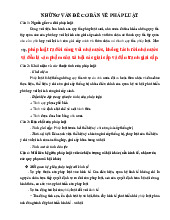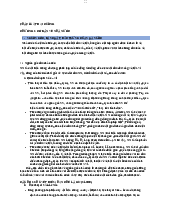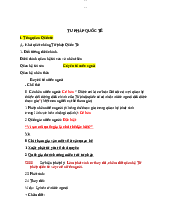













Preview text:
FINAL EXAM QUESTIONS:
Include all self-test and discussion questions from relevant chapters in Law Trove
Chapter 1: International law in the modern context
Self-test questions
1 Define ‘international law’. 2 Explain the difference between ‘public’ and
‘private’ international law. 3 What are ‘general international law’, ‘regional
international law’, and ‘particular international law’? 4 What functions does
international law perform? 5 Distinguish naturalism, positivism, and
Grotianism. 6 What is the basis of international law and is this enough for the
purpose of international law development? 7 Under what circumstances may
consent, as a basis of international law, be varied?
Discussion questions
1 To what extent is the assertion that international law is not law a true
reflection of international law? 2 ‘Without consent, there can be no
international law. Consent is the beginning and end of international law.’
Discuss. 3 Outline the various theories of law and discuss what relevance these
have to international law. Questions International law in the modern context
Page 25 of 26 (p. 23) 4 ‘International law is international law. The use of the
terms “private” and “public” to describe international law is a matter of
personal preference with no practical consequences.’ Do you agree? 5
‘Understanding positivism, naturalism, and Grotianism as theoretical
foundations of law says nothing about t
he foundation of international law.’ Discuss. 6 ‘The future of international law is
precarious.’ Evaluate this assertion.
Chapter 2:Sources of international law Self-test questions 1 What is ‘custom’?
2 What are the sources of international law?
3 Explain the persistent objector rule.
4 What does the phrase opinio juris imply and how is it determined?
5 What constitutes State practice?
6 Define ‘treaty’ and briefly outline its main features.
7 Suggest other possible sources of international law.
8 Distinguish between soft law and hard law. Discussion questions
1 Discuss State practice and opinio juris as the twin requirements for establishing the existence of custom.
2 ‘There is no hierarchy among the sources of customary international law listed in
Article 38(1) of the ICJ Statute. It is, in fact, nothing but an exercise in futility to
attempt to justify a ranking of some sort among these sources.’ To what extent does
this statement represent the true nature of the provisions contained in Article 38(1) of the ICJ Statute?
3 Critically examine the assertion that the relationship between treaty and custom, as
sources of international law, is too complex to make any sense.
4 ‘“Consistency” is an essential element of State practice. Once there is a slight
digression from a usage, it destroys its chances of ever becoming a custom.’ Discuss.
5 ‘“The general principles of law recognized by civilized nations” means general
principles of international law.’ Critically examine this statement.
6 ‘The persistent objector is nothing but a daydreamer whose claim is of no
consequence in international law.’ Discuss.
Statehood and recognition in international law Self-test questions
1 What are the criteria for statehood under the Montevideo Convention?
2 List the ‘new requirements’ of statehood adopted by the European Community in 1991.
(p. 154) 3 List the subjects of international law.
4 Explain the terms ‘declaratory theory’ and ‘constitutive theory’.
5 What does the ‘Estrada doctrine’ imply?
6 How do you understand the term ‘recognition’?
7 When must recognition be granted?
8 Explain the term ‘retroactive recognition’. Discussion questions
1 ‘The criteria for statehood under the Montevideo Convention are exhaustive and do
not permit any additional criteria or practices to be added.’ Discuss. Conclusion Questions
Statehood and recognition in international law Page 52 of 53
2 ‘A “defined territory” means a territory free from controversy or dispute.’ To what
extent does this assertion reflect the understanding of ‘defined territory’ under the Montevideo Convention?
3 What is the relationship between the Montevideo criteria of statehood and the ‘new
requirements’ proposed by Fawcett (1964–65, see section 4.3.2) and adopted by the European Community in 1991?
4 ‘Retroactive recognition is a matter of convenience in State relations; it is not a
principle of international law.’ Discuss.
5 ‘There is no duty of recognition in international law.’ Discuss.
International organizations Self-test questions
1 Define ‘international organizations’.
2 What types of international organization are there?
3 List the features of international organizations.
4 List the consequences of legal personality.
5 What is ‘capacity’ of international organizations?
6 What is your understanding of ‘legal personality’?
7 Who determines whether the acts of international organizations can be reviewed judicially?
8 What does ‘ultra vires’ mean? Discussion questions
1 ‘The International Court of Justice cannot review the decisions of organs of the
United Nations.’ With reference to case law, consider to what extent this statement
reflects the practice of the Court.
2 What is legal personality in relation to international organizations and how is this
determined in international law?
3 ‘There are many ways in which non-members of international organizations can
recognize the legal personality of such organizations.’ Discuss this assertion, with reference to decided cases.
4 What are the legal consequences of ultra vires decisions of international organizations?
Territory and the law of the sea Self-test questions
1 What do you understand by the term ‘territory’ in international law?
2 What elements comprise a State’s territory?
3 Explain the ‘cannon rule’.
4 Define ‘territorial water’.
5 What do you understand by the phrase ‘intertemporal law’?
6 Explain ‘acquisition by prescription’.
7 What are the ‘continental shelf’, an ‘exclusive economic zone’, and the ‘high seas’?
8 What are the forms of acquisition of territory in international law? (p. 235) Discussion questions
1 ‘A State that first physically occupies a territory retains sovereignty over it forever.’
To what extent is this statement true of the acquisition of territory in international law?
2 ‘Terra nullius is no-man’s-land. It is a wasteland that is not occupied by any
human, or which is occupied by tribes of barbarians and savages, and, as such, it is
open for occupation by the first civilized State to arrive on the scene.’ Discuss.
3 ‘Judicial determination of what constitutes effectivities for the purpose of
ascertaining the validity of territorial sovereignty is a precise and succinct exercise.’ Discuss.
4 ‘The breadth of the territorial sea is the sole problem that undermined the work of
the Territorial Waters Commission during the 1930 Conference on the Codification of
5 To what extent did UNCLOS I and II contribute to the development of the law of the sea?
6 What are the high and low points of UNCLOS III? Jurisdiction Self-test questions
1 Explain the term ‘jurisdiction’.
2 What requirement do States have to meet before they can exercise subjective territorial jurisdiction?
3 Distinguish between the nationality principle and the protective principle.
(p. 265) 4 In what circumstances will a State exercise the passive personality principle?
5 What do you understand by ‘universal jurisdiction’?
6 When will enforcement jurisdiction be illegal?
7 What is the territoriality principle?
8 Explain the phrase ‘the effect doctrine’. Discussion questions
1 ‘A State may exercise its territorial jurisdiction once a crime is committed on its
territory, regardless of where the crime starts or ends.’ Discuss.
2 ‘The “effect doctrine” and the “protective principle” are so similar that there is no
point in treating them separately.’ Critically examine this statement.
3 ‘A State can exercise universal jurisdiction over any crime committed abroad.’
Assess the validity of this statement.
4 ‘Once a State’s national has been injured abroad, that State has an unquestionable
right to exercise jurisdiction on the basis of the passive personality principle.’ Discuss.
5 ‘The forcible capturing of a criminal from an overseas territory is irrelevant to his or
her subsequent prosecution in the capturing State.’ Critically examine this statement.
6 ‘Jurisdiction is a generic term and can mean different things in different circumstances.’ Discuss.
The law of use of force Self-test questions
1 What does ‘force’ mean under Article 2(4) of the UN Charter?
2 Explain the meaning of ‘territorial integrity’ and of ‘political independence’.
3 What do we mean by ‘armed attack’ under Article 51 of the UN Charter?
4 What is ‘anticipatory self-defence’?
5 How did the ICJ define ‘threat’ in Nuclear Weapons?
6 Distinguish ‘individual self-defence’ from ‘collective self-defence’. Discussion questions
1 ‘There is no armed attack unless the regular forces of a State attack another State.’ Discuss.
2 ‘To constitute a violation of territorial integrity and political independence of a State,
the use of force against that State must reduce the size of its territory and instigate a
change of its government.’ Critically examine this statement.
(p. 369) 3 ‘Article 2(4) of the UN Charter is an absolute prohibition of the use or
threat of force.’ Analyse the validity of this statement in light of writers’ and States’
approaches to interpreting the Article.
4 ‘An attacked State must make a formal request to others before there can be a right
of collective self-defence and it is important that third States willing to help the
attacked State must justify their involvement by some measure.’ Critically examine
this statement, with reference to the ICJ decision in the Nicaragua Case and Sir
Robert Jennings’s dissention.
5 ‘There is considerable support for anticipatory self-defence in contemporary
international society. Even the UN Security Council has lent greater support to this
practice in the aftermath of the 9/11 attacks in the USA.’ Critically examine this
statement, with reference to State practice and particular post-2001 Security Council resolutions
Collective security Self-test questions
1 What is ‘collective security’?
2 What powers does the UN Security Council have under Article 39 of the UN Charter?
3 Identify the essential features of peacekeeping operations.
4 What is ‘humanitarian intervention’?
5 Explain the difference between ‘recommendations’ and ‘decisions’ of the UN Security Council.
6 What does ‘threat of force’ mean?
7 Distinguish between ‘collective self-defence’ and ‘collective security’. (p. 411) Discussion questions
1 List the stages of the process outlined by the UN Security Council in Articles 39–42.
2 Define ‘humanitarian intervention’ and explain its main features.
3 ‘States can use force against each another as long as such force is not against
their territorial integrity or political independence.’ Critically examine this statement.
4 ‘The only power that regional organizations have is to settle disputes among their
members peacefully.’ Evaluate this statement in light of Chapter VIII of the UN Charter.
5 List the differences between humanitarian intervention and the responsibility to Conclusion Questions Collective security Page 47 of 48 protect people (R2P).
International humanitarian law Self test questions
1 Define the law of armed conflict.
2 Distinguish jus ad bellum from jus in bello.
(p. 437) 3 When does an international armed conflict occur and to what extent do
the requirements of international armed conflicts differ from internal armed conflicts?
4 What are military objects and objectives?
5 Who are unlawful combatants and what is the stance of IHL on this category?
6 How does IHL regulate the choice of weapons in hostilities? Discussion questions
1 Customary international law plays a complementary role to IHL. Explain.
2 Trace the development of IHL from 1856 to 1949.
3 Explain the differences, if any, between armed conflict of international character
and armed conflicts of non-international character.
4 Discuss the term ‘collateral damage’.
5 Explain what you understand by proportionality and distinction.
6 Discuss civilian objects and military objectives.
State responsibility Self-test questions
1 Explain the term ‘State responsibility’.
2 What does the phrase ‘internationally wrongful acts’ mean?
3 What are the conditions necessary for international responsibility?
4 Distinguish between ‘acts of instructed persons’ and ‘acts of directed or controlled persons’.
5 What is the difference between objective responsibility and risk theories?
(p. 487) 6 Explain what is meant by ‘exhaustion of local remedies’.
7 Under what circumstances may responsibility for breaches of international obligations be precluded? Discussion questions
1 Discuss the requirements of lawful expropriation.
2 With reference to relevant cases, explain the basis of the diplomatic protection of nationals.
3 Examine the circumstances precluding internationally wrongful acts.
4 Discuss the ‘exhaustion of local remedies’ as a condition for diplomatic protection.
5 Discuss the various standards of treatment of aliens.
6 Discuss the various reparations available to an injured State.
International economic law Self test questions
1 What is ‘international economic law’?
2 Explain what is meant by the ‘Bretton Woods institutions’.
3 What is the relationship between international economic law and public international law?
4 Explain ‘conditionality’ in the context of the IMF.
5 What do ‘nullification’ and ‘impairment’ mean in the context of GATT?
6 Why was the Bank of the South established? 7 What is the IBRD?
8 Explain what is meant by ‘surveillance’. Discussion questions
1 Explain the functions of the IMF.
2 What are the major weaknesses of the GATT/WTO system?
(p. 690) 3 To what extent does the dispute settlement system under GATT 1947
differ from that under GATT 1994?
4 Explain why public international law was slow to regulate international economics.
5 Which types of State can access the World Bank loan facilities?




